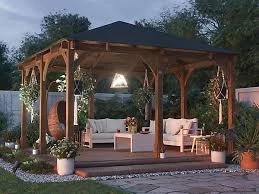Outdoor spaces have become an extension of our homes, offering a place to relax, entertain, and enjoy fresh air year-round. To make the most of these areas, some form of shelter is essential. Two popular choices are heavy duty permanent gazebo and temporary canopies. While both provide shade and protection, they differ greatly in durability, style, and long-term value.

If you’re considering investing in a garden or patio shelter, here’s a detailed look at how a permanent gazebo stacks up against a canopy, and which option may be better suited to your needs.
Understanding Permanent Gazebos
A permanent gazebo is a solid, long-term addition to an outdoor space. Built with strong materials such as powder-coated steel, aluminum, or treated wood, these structures are designed to stay in place all year. Many models come with weatherproof roofing panels and sturdy frames capable of withstanding wind, rain, and even snow.
For extra comfort, gazebos often include side panels or curtains. These allow you to enclose the space when needed, creating privacy and keeping out the chill on breezy evenings. In the UK especially, permanent gazebos that can handle all-weather conditions have become popular, as they provide reliable protection through unpredictable seasons.
What Makes a Temporary Canopy Different
A temporary canopy is a lightweight, portable structure typically made with polyester fabric and collapsible frames. These are easy to assemble and disassemble, making them a go-to for quick shade at outdoor events, garden parties, or camping trips.
Their biggest strength lies in convenience. A canopy can be set up in a matter of minutes and packed away just as quickly. Compact versions are especially handy for travel or occasional use. However, because of their design, they aren’t built for permanent outdoor living or harsh weather.
Durability: The Key Difference
When comparing these two options, durability is where permanent gazebos clearly stand out.
- Permanent gazebos are built to last for years. With reinforced roofing, drainage systems, and rust-resistant materials, they can handle rain, wind, and sun exposure without quickly deteriorating. Some are even designed to remain stable in heavy snow or storms.
- Temporary canopies, on the other hand, are only reliable in mild weather. Strong winds or heavy rainfall can cause fabric tears or frame damage, and prolonged sun exposure leads to fading.
If your goal is a long-term investment in your garden, a permanent structure offers far greater resilience.
Costs and Long-Term Value
At first glance, canopies are appealing because of their affordability. Many cost less than £100 and provide quick, temporary shelter. For those who only need occasional coverage, this can be a practical choice.
Permanent gazebos, however, require a higher upfront investment. Prices vary widely, from a few hundred pounds for smaller metal options to several thousand for large, high-end designs. But because they last for many years, the long-term value is significantly better. Instead of replacing a canopy every couple of seasons, you invest once in a structure that becomes a permanent feature of your home.
Ease of Setup and Maintenance
Temporary canopies win when it comes to ease of setup. They’re designed for convenience and can usually be assembled in under half an hour without tools. For short-term use, this simplicity is hard to beat.
Permanent gazebos require more time and effort. Some can be built by two people over a weekend, while others may need professional installation. Once in place, though, they need minimal maintenance. Occasional cleaning and checking for loose bolts is usually enough to keep them in good condition year after year.
Style and Design Considerations
A canopy serves its function but does little for the overall appearance of a garden. It’s practical but not decorative.
A permanent gazebo, on the other hand, can transform an outdoor space. With elegant frames, roofing designs, and optional sides or curtains, these structures add both beauty and function. Many homeowners choose to design outdoor dining areas, lounges, or hot tub enclosures around their gazebo, turning a simple garden into a stylish extension of their living space.
When to Choose a Canopy vs. a Gazebo
- A canopy is best for:
- Occasional use at outdoor events or parties
- Travel and camping trips
- Those who need shade on a tight budget
- A permanent gazebo is best for:
- Creating a year-round garden feature
- Protecting outdoor furniture and dining spaces from all weather
- Adding style, privacy, and value to a property
- Anyone seeking a long-term investment rather than a short-term fix
Final Thoughts
Both permanent gazebos and temporary canopies have their place, but the choice ultimately depends on your lifestyle and priorities. If you only need shade a few times a year, a compact canopy is inexpensive and convenient. But if you want a reliable structure that can withstand the elements, enhance the beauty of your garden, and serve as a permanent retreat, a heavy duty gazebo is the better option.
In the long run, a gazebo isn’t just about shelter—it’s about creating an outdoor space you can enjoy in comfort and style throughout the seasons.



